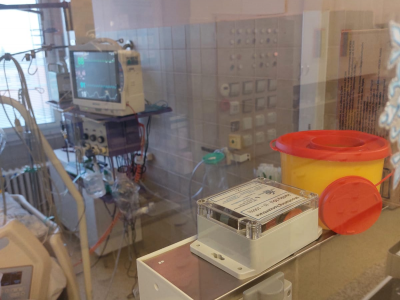COVID-19
To access this dataset without purchasing an IEEE Dataport subscription, please visit: https://zenodo.org/doi/10.5281/zenodo.11711229
Please cite the following paper when using this dataset:
- Categories:
 1020 Views
1020 Views
This research utilized data from the Oxford University Our World in Data Covid 19 Dataset. This dataset contains data points collected on an ongoing basis from Johns Hopkins University, Center for Systems Science and Engineering COVID-19 data, European Centre for Disease Control, and OXFORD COVID-19 Government Response Tracker, from January 2020 to the present.
- Categories:
 310 Views
310 ViewsThis dataset contains measured data from five sensor modules designed for monitoring the oxygen concentration in the air in a hospital environment, especially in rooms where oxygen therapy can potentially occurs. This data is crucial from a safety point of view, as a higher oxygen concentration can increase the risk of fire development.
- Categories:
 593 Views
593 Views
Data on 2355 COVID-19 cases by date of July to December 2021 were extracted from a data set recorded by COVID-19 referral centers at Qazvin province in Iran. We recorded a wide range of clinical characteristics including age, sex, previous diseases, and hospitalization time. Moreover, we collected data about the different consumed medications including Atrovastatin 20 mg, Atrovastatin 40 mg, Ivermectin 3 mg, Ivermectin 40 mg, Dexamethasone, Kaletra, Favipiravir, Famotidine 40 mg, Interferon, Remdesivir, Hydroxychloroquine.
- Categories:
 405 Views
405 ViewsPlease cite the following paper when using this dataset:
N. Thakur, K. A. Patel, I. Hall, Y. N. Duggal, and S. Cui, “A Dataset of Search Interests related to Disease X originating from different Geographic Regions”, Preprints 2023, 2023081701, DOI: https://doi.org/10.20944/preprints202308.1701.v1
Abstract:
- Categories:
 716 Views
716 Views
The complete COVID-19 dataset is a collection of the COVID-19 data maintained by Our World in Data that is updated throughout the duration of COVID-19. It includes information related to confirmed cases and deaths, hospitalization, intensive care unit admissions, testing for COVID-19, and vaccination for COVID-19.
- Categories:
 1118 Views
1118 Views
This dataset is a subset from the Oxford University Our World in Data Covid 19 Dataset. This dataset contains data points collected on an ongoing basis from Johns Hopkins University, Center for Systems Science and Engineering COVID-19 data, OXFORD COVID-19 Government Response Tracker, and European Centre for Disease Control, from January 2020 to present.
- Categories:
 171 Views
171 Views
This Named Entities dataset is implemented by employing the widely used Large Language Model (LLM), BERT, on the CORD-19 biomedical literature corpus. By fine-tuning the pre-trained BERT on the CORD-NER dataset, the model gains the ability to comprehend the context and semantics of biomedical named entities. The refined model is then utilized on the CORD-19 to extract more contextually relevant and updated named entities. However, fine-tuning large datasets with LLMs poses a challenge. To counter this, two distinct sampling methodologies are utilized.
- Categories:
 355 Views
355 ViewsPlease cite the following paper when using this dataset:
N. Thakur, K. Khanna, S. Cui, N. Azizi, and Z. Liu, “Mining and Analysis of Search Interests related to Online Learning Platforms from Different Countries since the Beginning of COVID-19” [Unpublished Paper - Paper submitted to HCI International 2023, Copenhagen, Denmark, 23-28 July 2023]
Brief Description of Dataset file - Interest_Dataset.csv:
Attribute Name: Week
- Categories:
 244 Views
244 ViewsPlease cite the following paper when using this dataset:
N. Thakur, K. Khanna, S. Cui, N. Azizi, and Z. Liu, “Mining and Analysis of Search Interests related to Online Learning Platforms from Different Countries since the Beginning of COVID-19” [Unpublished Paper - Paper submitted to HCI International 2023, Copenhagen, Denmark, 23-28 July 2023]
Brief Description of Dataset file - Interest_Dataset.csv:
Attribute Name: Week
- Categories:
 Views
Views



